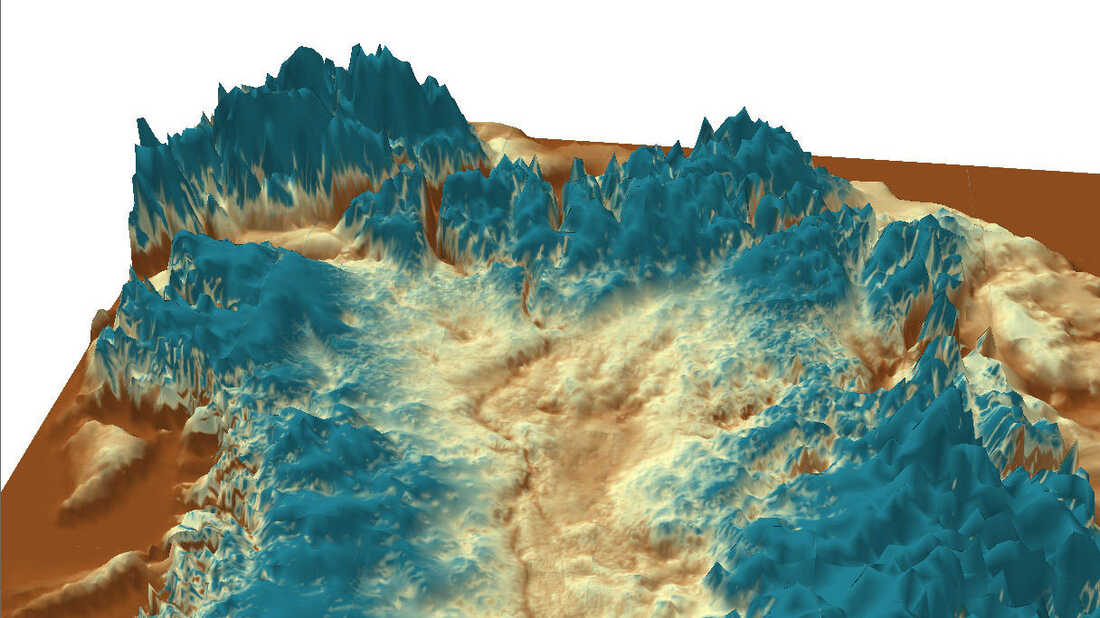U.S. Military Base Beneath Greenland's Ice: Unveiling A Hidden History

Table of Contents
Greenland, the world's largest island, holds a strategically vital position in the Arctic. During the Cold War, the region became a focal point for military activity, fueling a tense geopolitical game of cat and mouse between the United States and the Soviet Union. This article will explore the evidence and theories surrounding a potential U.S. military installation beneath Greenland's immense ice sheet, examining its historical context and its continuing relevance.
Project Iceworm: The Cold War's Secret Weapon
Project Iceworm, launched in the early 1960s, was a highly classified U.S. military operation aimed at establishing a network of underground bases beneath the Greenland ice sheet. Its primary goal was to deter a potential Soviet attack by deploying nuclear missiles within striking distance of the USSR. The project's location in Greenland offered strategic advantages, including its proximity to the Soviet Union and the relative inaccessibility of its vast, icy landscape.
- Technological Challenges: Project Iceworm faced immense technological hurdles. The constant movement of the Greenland ice sheet posed a significant challenge to constructing and maintaining stable underground facilities. The project also relied on a complex, nuclear-powered infrastructure to support its operations in this extreme environment.
- Ultimate Failure: Despite significant investment and technological innovation, Project Iceworm ultimately failed. The unpredictable nature of the ice, coupled with logistical and engineering difficulties, proved insurmountable. The project was officially abandoned in 1966.
- Declassification and Public Knowledge: The declassification of documents related to Project Iceworm in recent decades has shed light on this ambitious, yet ultimately unsuccessful, Cold War endeavor. This release has fuelled further interest and speculation about the project's legacy.
Evidence and Speculation: What Remains Today?
While Project Iceworm officially ended decades ago, questions remain about its lingering impact. The vastness of the Greenland ice sheet makes a comprehensive search for remaining infrastructure incredibly difficult, fueling speculation about what might still be buried beneath the ice.
- Possible Locations: Pinpointing potential locations of any remaining infrastructure or equipment from Project Iceworm is extremely challenging. The melting ice and natural processes of the ice sheet have likely obscured any traces over time.
- Environmental Impact: The environmental impact of Project Iceworm is a crucial area of concern. The potential for radioactive contamination from the project's nuclear power sources remains a subject of ongoing investigation and debate. The melting of the Greenland ice sheet adds another layer of complexity to assessing potential environmental damage.
- Ongoing Research and Exploration: Scientists and researchers are increasingly interested in using modern geophysical techniques to map the subsurface of the Greenland ice sheet. This could potentially reveal clues about the project's remnants or other unforeseen structures.
Geophysical Anomalies and Modern Interpretations
Advances in geophysical surveying techniques, including satellite imagery and ice-penetrating radar, offer new avenues for exploring the subsurface of the Greenland ice sheet. While these technologies offer significant potential, they also have limitations in the extreme environment of Greenland.
- Limitations of Technology: The thickness and dynamics of the ice sheet pose challenges to current geophysical exploration techniques. Obtaining clear, unambiguous data about subsurface structures requires sophisticated methods and careful interpretation.
- Credible Scientific Studies: Several scientific studies have examined geophysical anomalies in Greenland, attempting to distinguish between natural geological formations and potential man-made structures. However, definitive conclusions about any remaining elements of Project Iceworm remain elusive.
- Separating Fact from Fiction: It’s crucial to differentiate between credible scientific findings and unsubstantiated claims regarding potential underground structures in Greenland. Responsible reporting relies on evidence-based analysis.
The Geopolitical Significance of a Hidden Base
The existence—or non-existence—of a hidden U.S. military base beneath Greenland's ice carries significant geopolitical implications in the 21st century. The Arctic is experiencing a period of increased geopolitical attention due to its strategic importance in resource extraction, expanding shipping routes, and the impact of climate change.
- Arctic Geopolitics: The Arctic region is increasingly important for resource extraction, particularly oil and gas, as well as for new shipping routes opened up by melting sea ice. This makes the area a focus of competition between various nations.
- Military Advantages: A hidden base in the Arctic would offer significant military advantages, such as strategic positioning and the ability to monitor activities in the region. The idea of such a facility holds lasting strategic importance for several nations.
- Ethical and Environmental Concerns: Any exploration or potential recovery efforts related to Project Iceworm must prioritize ethical and environmental considerations. The protection of the fragile Arctic environment is paramount. Greenland's sovereignty must also be respected.
Conclusion
The mystery surrounding a potential U.S. military base beneath Greenland's ice remains a compelling chapter in Cold War history. Project Iceworm's ambition, technological challenges, and ultimate failure offer valuable lessons in strategic planning and technological limitations. The lingering questions about potential remnants, environmental impact, and the continuing geopolitical significance of the Arctic highlight the importance of ongoing research and responsible exploration. To further your understanding of this fascinating topic, explore keywords like “U.S. military bases in Greenland,” “Project Iceworm research,” and “Greenland Arctic exploration.” The ice may hide many secrets, but persistent investigation may yet reveal the full story of this enigmatic piece of Cold War history, and the future of U.S. military bases beneath Greenland's ice.

Featured Posts
-
 Rfk Jr And Family Swim In Rock Creek Despite High Bacteria Levels
May 16, 2025
Rfk Jr And Family Swim In Rock Creek Despite High Bacteria Levels
May 16, 2025 -
 Sheikh Hasinas Party Faces Election Ban In Bangladesh
May 16, 2025
Sheikh Hasinas Party Faces Election Ban In Bangladesh
May 16, 2025 -
 Baby Name Trends 2024 Familiar Names Remain Popular
May 16, 2025
Baby Name Trends 2024 Familiar Names Remain Popular
May 16, 2025 -
 Court Approves Hudsons Bays Creditor Protection Extension To July 31
May 16, 2025
Court Approves Hudsons Bays Creditor Protection Extension To July 31
May 16, 2025 -
 Gambling On Disaster The Troubling Rise Of Wildfire Betting
May 16, 2025
Gambling On Disaster The Troubling Rise Of Wildfire Betting
May 16, 2025
Latest Posts
-
 Padres Counter Strategy How San Diego Aims To Thwart The Dodgers
May 16, 2025
Padres Counter Strategy How San Diego Aims To Thwart The Dodgers
May 16, 2025 -
 Three Hits For Simpson Tampa Bay Rays Sweep San Diego Padres
May 16, 2025
Three Hits For Simpson Tampa Bay Rays Sweep San Diego Padres
May 16, 2025 -
 Dodgers Masterplan Faces Padres Challenge Intense Rivalry Shaping The Season
May 16, 2025
Dodgers Masterplan Faces Padres Challenge Intense Rivalry Shaping The Season
May 16, 2025 -
 Resilient Padres Overcome Cubs For Hard Fought Win
May 16, 2025
Resilient Padres Overcome Cubs For Hard Fought Win
May 16, 2025 -
 Tampa Bay Rays Defeat San Diego Padres Simpsons Three Hits Power The Sweep
May 16, 2025
Tampa Bay Rays Defeat San Diego Padres Simpsons Three Hits Power The Sweep
May 16, 2025
